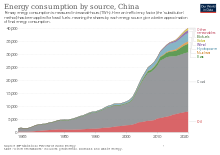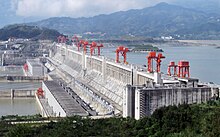This article needs to be updated. (April 2024) |



China is both the world's largest energy consumer and the largest industrial country, and ensuring adequate energy supply to sustain economic growth has been a core concern of the Chinese Government since the founding of the People's Republic of China in 1949.[1] Since the country's industrialization in the 1960s, China is currently the world's largest emitter of greenhouse gases, and coal in China is a major cause of global warming.[2] China is also the world's largest renewable energy producer (see this article), and the largest producer of hydroelectricity, solar power and wind power in the world. The energy policy of China is connected to its industrial policy, where the goals of China's industrial production dictate its energy demand managements.[3]
Being a country that depends heavily on foreign petroleum import for both domestic consumption and as raw materials for light industry manufacturing, electrification is a huge component of the Chinese national energy policy.
- ^ Andrews-Speed, Philip (November 2014). "China's Energy Policymaking Processes and Their Consequences". The National Bureau of Asian Research Energy Security Report. Retrieved December 5, 2014.
- ^ McGrath, Matt (November 20, 2019). "China coal surge threatens Paris climate targets". Retrieved December 9, 2019.
- ^ Rosen, Daniel; Houser, Trevor (May 2007). "China Energy A Guide for the Perplexed" (PDF). piie.com. Retrieved April 25, 2020.